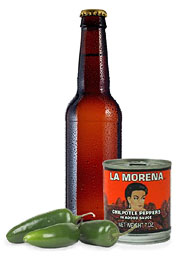 Are you ready for some fire?
Are you ready for some fire?
If you’re a fan of spicy foods, you might want to try to brew a spicy beer made with hot chile peppers. It’s definitely a specialty item, but sometimes that extra kick can give your tastes buds a much needed wake-up call.
Not sure if spicy beer is for you? Try some commercial examples before brewing your own hot chile pepper beer. Twisted Pine’s Ghost Face Killah, Rogue Brewery’s Chipotle Ale, and Dogfish Head’s Theobroma are all made with hot peppers and are pretty well regarded among craft beer fans. Levels of spice will vary from beer to beer, but if you can stand the heat, keep reading.
Brewing beers with unusual ingredients may sound intimidating, but it’s actually pretty easy. Here are some instructions for brewing your own Chipotle Smoked Porter, inspired by Stone Brewing Company’s Chipotle Smoked Porter. Feel free to substitute the base beer or switch type of pepper to come up with your own variation!
- First, consider whether you really want several gallons of spicy beer. Maybe a friend will join in and split the experiment with you?
- Once you’ve decided that you’re willing to give it a try, start out with a Robust Porter recipe kit, a Smoked Porter recipe kit, or an all-grain porter recipe. To add smoked flavor, just add 1/4 to 1 lb. of smoked malt to your grain bill, depending on the intensity of smoked flavor you’re going for. (By the way, it is possible to smoke your own malt, if you’re so inclined.)
- Buy a small can of chipotle peppers. Chipotle is just a fancy word for smoked jalepeños. It won’t take much to add significant heat to your brew, so a 3-6 oz. can will be plenty!
- Chipotles peppers are often packed in adobo sauce. On brew day, rinse the chipotles to get most of the sauce off of them. Whatever you do, don’t rub your eyes after handling the peppers!
- Add the peppers about halfway through the boil. Don’t feel like you have to use the whole can — just a few peppers will definitely be noticeable! Want to go nuts? Brew at your own risk!
- Proceed with your brew as you would otherwise.
- After 2-3 weeks of bottle conditioning (or after carbonating your keg) sample some of your spicy beer. If it’s too hot, allow the beer to age a bit. The spice will mellow out over time.
Spicy beer is definitely an acquired taste — be prepared because not everyone will like it. I for one love these chipotle smoked porters, so I think it’s worth a shot.
Have you brewed chile beers before? What peppers did you use? What base style?
——————————————————————————————————-
David Ackley is a beer writer, brewer, and self-described “craft beer crusader.” He holds a General Certificate in Brewing from the Institute of Brewing and Distilling and is founder of the Local Beer Blog.

I like ginger. What additives are needed to assist clearing in beer. I also love wine. I made a hop/ginger wine using a JJ Berry recipe and had to bentonite twice to get it clear. The ginger was sliced very thin and boiled before adding. Usual pectin enzyme was added plus a little more as I figured clearing would be an issue but not that bad. After aging I could not get the ginger – but the hop aroma and taste (I poured the hot wort over cones which then went into ice for dilution before adding enzymes, SG level – capitalize, yeast energizer and yeast.) I guess the question is what greatly assists root crops in wine making to prevent cloudiness and assists clearing? Thanks
Gelatin
Paul, you can find beer clarifiers on our website at the link below:
Beer Clarifiers
http://www.eckraus.com/beer-brewing/beer-brewing-ingredients/beer-additives/beer-finings-clarifiers/